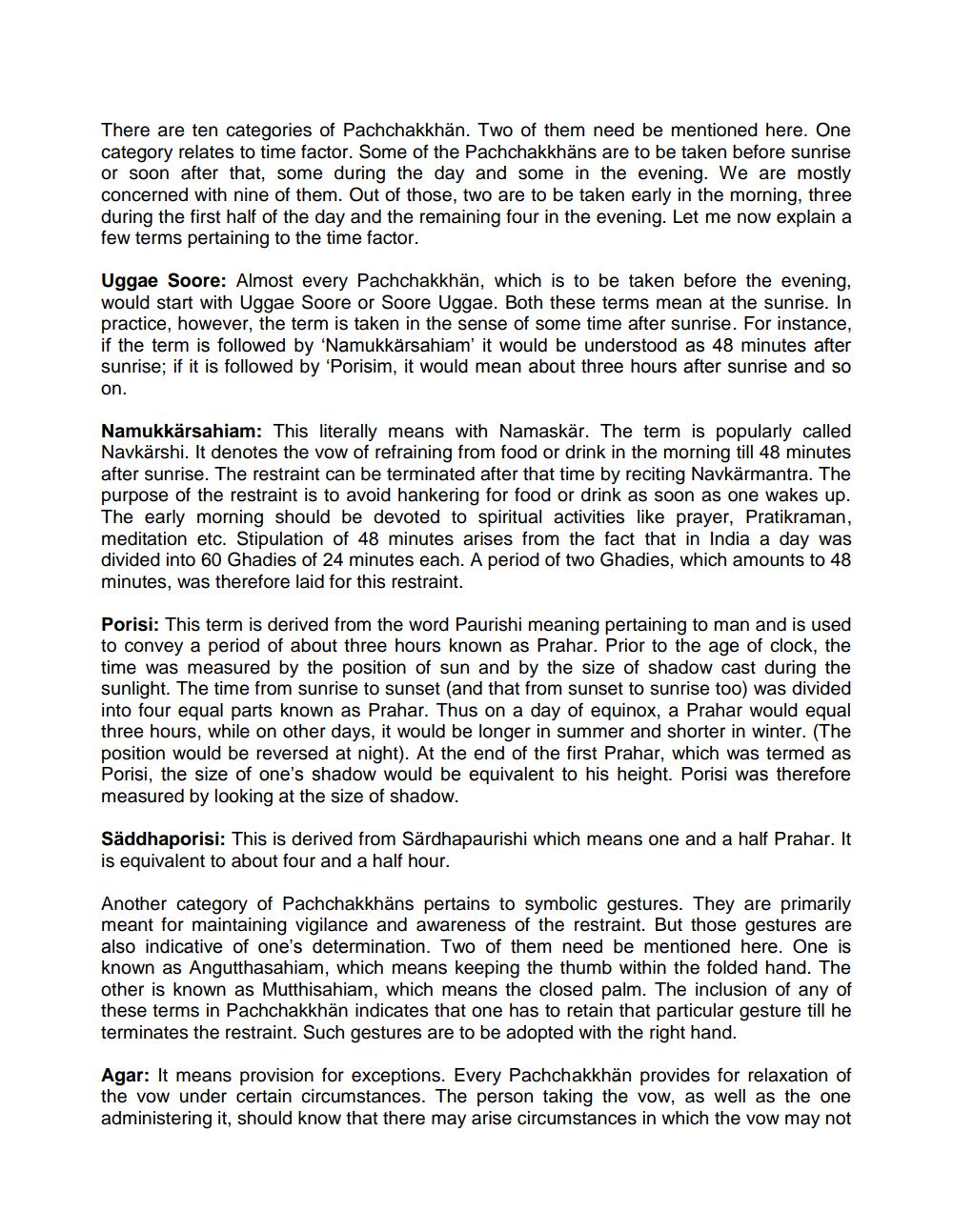________________
There are ten categories of Pachchakkhän. Two of them need be mentioned here. One category relates to time factor. Some of the Pachchakkhäns are to be taken before sunrise or soon after that, some during the day and some in the evening. We are mostly concerned with nine of them. Out of those, two are to be taken early in the morning, three during the first half of the day and the remaining four in the evening. Let me now explain a few terms pertaining to the time factor.
Uggae Soore: Almost every Pachchakkhän, which is to be taken before the evening, would start with Uggae Soore or Soore Uggae. Both these terms mean at the sunrise. In practice, however, the term is taken in the sense of some time after sunrise. For instance, if the term is followed by 'Namukkärsahiam' it would be understood as 48 minutes after sunrise; if it is followed by 'Porisim, it would mean about three hours after sunrise and so on.
Namukkärsahiam: This literally means with Namaskär. The term is popularly called Navkärshi. It denotes the vow of refraining from food or drink in the morning till 48 minutes after sunrise. The restraint can be terminated after that time by reciting Navkärmantra. The purpose of the restraint is to avoid hankering for food or drink as soon as one wakes up. The early morning should be devoted to spiritual activities like prayer, Pratikraman, meditation etc. Stipulation of 48 minutes arises from the fact that in India a day was divided into 60 Ghadies of 24 minutes each. A period of two Ghadies, which amounts to 48 minutes, was therefore laid for this restraint.
Porisi: This term is derived from the word Paurishi meaning pertaining to man and is used to convey a period of about three hours known as Prahar. Prior to the age of clock, the time was measured by the position of sun and by the size of shadow cast during the sunlight. The time from sunrise to sunset (and that from sunset to sunrise too) was divided into four equal parts known as Prahar. Thus on a day of equinox, a Prahar would equal three hours, while on other days, it would be longer in summer and shorter in winter. (The position would be reversed at night). At the end of the first Prahar, which was termed as Porisi, the size of one's shadow would be equivalent to his height. Porisi was therefore measured by looking at the size of shadow.
Säddhaporisi: This is derived from Särdhapaurishi which means one and a half Prahar. It is equivalent to about four and a half hour.
Another category of Pachchakkhäns pertains to symbolic gestures. They are primarily meant for maintaining vigilance and awareness of the restraint. But those gestures are also indicative of one's determination. Two of them need be mentioned here. One is known as Angutthasahiam, which means keeping the thumb within the folded hand. The other is known as Mutthisahiam, which means the closed palm. The inclusion of any of these terms in Pachchakkhän indicates that one has to retain that particular gesture till he terminates the restraint. Such gestures are to be adopted with the right hand.
Agar: It means provision for exceptions. Every Pachchakkhän provides for relaxation of the vow under certain circumstances. The person taking the vow, as well as the one administering it, should know that there may arise circumstances in which the vow may not




